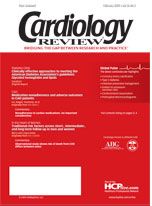Publication
Article
Cardiology Review® Online
Myocardial vasodilatation with simvastatin versus pravastatin in patients with hypercholesterolemia
As a result of evidence that HMG-CoA reductase inhibitors (statins) may have direct actions against diffuse coronary artery damage in addition to a cholesterol-lowering effect, much research is being focused on the potential pleiotropic effects of statins. Clinical studies with positron emission tomography (PET) that can quantify myocardial blood flow (MBF)1 have shown that the myocardial vasodilatation index (MVI) can be reduced in patients without evidence of coronary artery disease (CAD).2-7 Cholesterol-lowering drugs, including statins, have been reported to improve the MVI.8-11 Studies of the effects of statins on impaired MVI in hyperlipidemic patients, however, have been inconsistent.8-12
The objective of the present randomized study was to evaluate the effect of simvastatin (Zocor) and pravastatin (Pravachol) therapy on impaired MVI in patients with increased cholesterol levels.
Patients and methods
We compared nondiabetic hypercholesterolemic patients without hyperten-
sion and without evidence of CAD who had not previously taken lipid-lowering drugs (n = 44) with normal control subjects (n = 22). Patients were randomly assigned to pravastatin (10—20 mg/day; n = 22) or simvastatin therapy (5–10 mg/day; n = 22). Baseline MBF and MBF during hyperemic stress with dipyridamole loading (MBF-dipyridamole) were measured with [13N]ammonia and PET before treatment and 8 to 12 months after treatment. The MVI was computed by dividing MBF-dipyridamole by the baseline MBF. The mean length of time for treatment in the pravastatin and simvastatin groups was 10.2 ± 2.1 and 10.1 ± 1.9 months, respectively.
Results
Patients in the pravastatin and simvastatin groups were similar with regard to general characteristics (Table 1). Baseline total cholesterol and low-density lipoprotein (LDL) cholesterol levels were also similar, and both total cholesterol and LDL cholesterol levels were markedly higher than those in the control group (Table 2). For both treatment groups, the total cholesterol level was markedly decreased at the end of therapy, and the LDL cholesterol level fell to the same level as the control group (Table 2). There was no significant difference in percent change in total cholesterol and LDL cholesterol between the two treatment groups.
The three groups were similar at baseline with regard to MBF. Baseline MBF in the two treatment groups did not change throughout the study (Figure 1). The MBF-dipyridamole, however, was significantly lower in both treatment groups than in the control group before treatment, although there was no difference in MBF-dipyridamole before therapy between the two treatment groups. Simvastatin significantly increased MBF-dipyridamole to the control level, whereas pravastatin did not (Figure 2).
Baseline MVI in the two treatment groups was similar before therapy and was significantly lower than in the control group. After treatment, however, simvastatin significantly increased MVI to the level of the control group, whereas pravastatin did not (Figure 3).
The two treatment groups had no significant change in baseline MBF after treatment. Furthermore, MBF-dipyridamole in the simvastatin group before therapy was not significantly different from that of the pravastatin group. Percent change for MVI in the simvastatin group, however, was significantly higher than that in the pravastatin group. Percent change for MVI in the simvastatin group showed weak but significant negative correlations with percent change in total cholesterol and LDL cholesterol levels.
Discussion
Studies of the effects of statins on impaired MVI in hyperlipidemic patients have produced varying results, namely, a significant improvement from simvastatin or fluvastatin treatment7-11 and no significant improvement from pravastatin.12 The effect of statins on MVI, however, has not been compared directly.
In this study, MBF-dipyridamole and MVI were significantly reduced in hypercholesterolemic patients, and both were reversed by simvastatin but not by pravastatin. Because study patients had little likelihood of developing CAD, reduced MVI can be credited to diffuse injury to the coronary arteries. Simvastatin, therefore, had a direct effect on improvement of myocardial vasodilatory function via improvement of the injury to the coronary arteries, whereas pravastatin did not, despite the fact that the improvement in lipid fractions for both simvastatin and pravastatin was comparable.
Our results indicate a difference in the effects of simvastatin and prava-statin on the impaired MVI in hyper-cholesterolemic patients. Furthermore, improvement of MVI is not attributed to the improvement of plasma lipid fractions but to some other mechanism. Improvement in lipid profiles is not the only advantage of statins. These drugs also favorably affect blood vessels, and differences in pleiotropic effects between pravastatin, which is hydrophilic, and simvastatin, which is lipophilic, have been reported. Simvastatin has also been shown to induce apoptosis of vascular smooth muscle cells, as well as to inhibit the abnormal proliferation and migration of smooth muscle cells, whereas pravastatin has not. Improvement of MVI is most likely the result of the direct vascular effects of statins, and differences in such effects explain our results, which showed that only simvastatin improved MVI. The mechanisms involved in the improvement of MVI remain uncertain; this suggests that statins may affect coronary circulation not through the reduction of lipid levels but through other actions, which may vary among statins. With simvastatin treatment, improvement of MVI correlated weakly but significantly with lipid fractions. This may possibly be because the improvement of MVI and the lipid-lowering effects depend partially on a common factor, such as the drug’s bioavailability.
In patients with high cholesterol levels, studies have shown that pra-
vastatin beneficially affects endothelial function, but not MVI, which indicates that increasing endothelial function is not related directly to improvement of MVI. Simvastatin’s beneficial effects on MVI may be attributed to an improvement in diffuse coronary damage.
Conclusions
Statins have direct beneficial effects on blood vessels in addition to their cholesterol-lowering properties, and the extent of these novel pleiotropic effects differs according to the individual statin. Simvastatin improves impaired myocardial vasodilatation function through some mechanism other than its cholesterol-lowering action.
